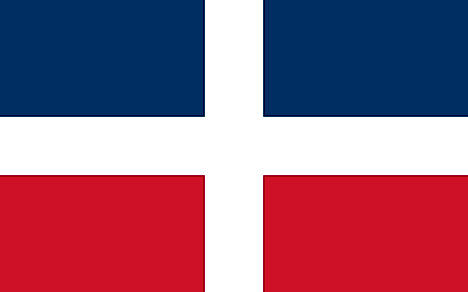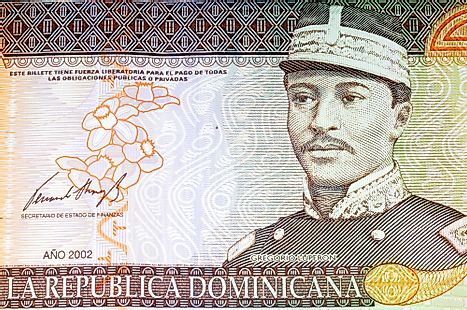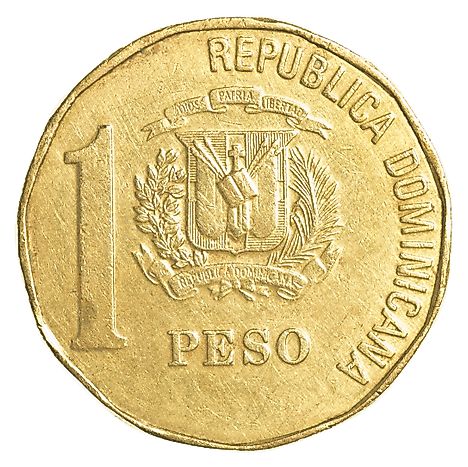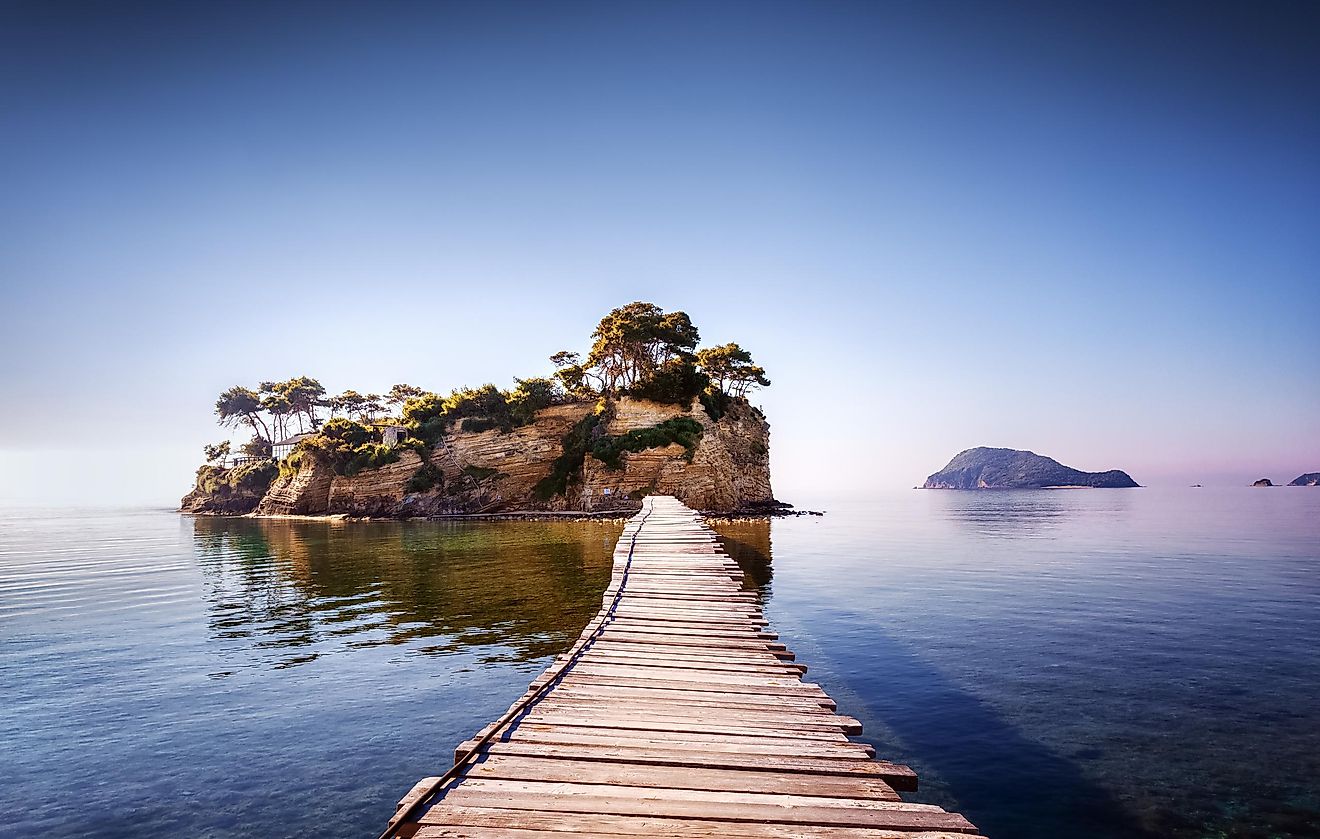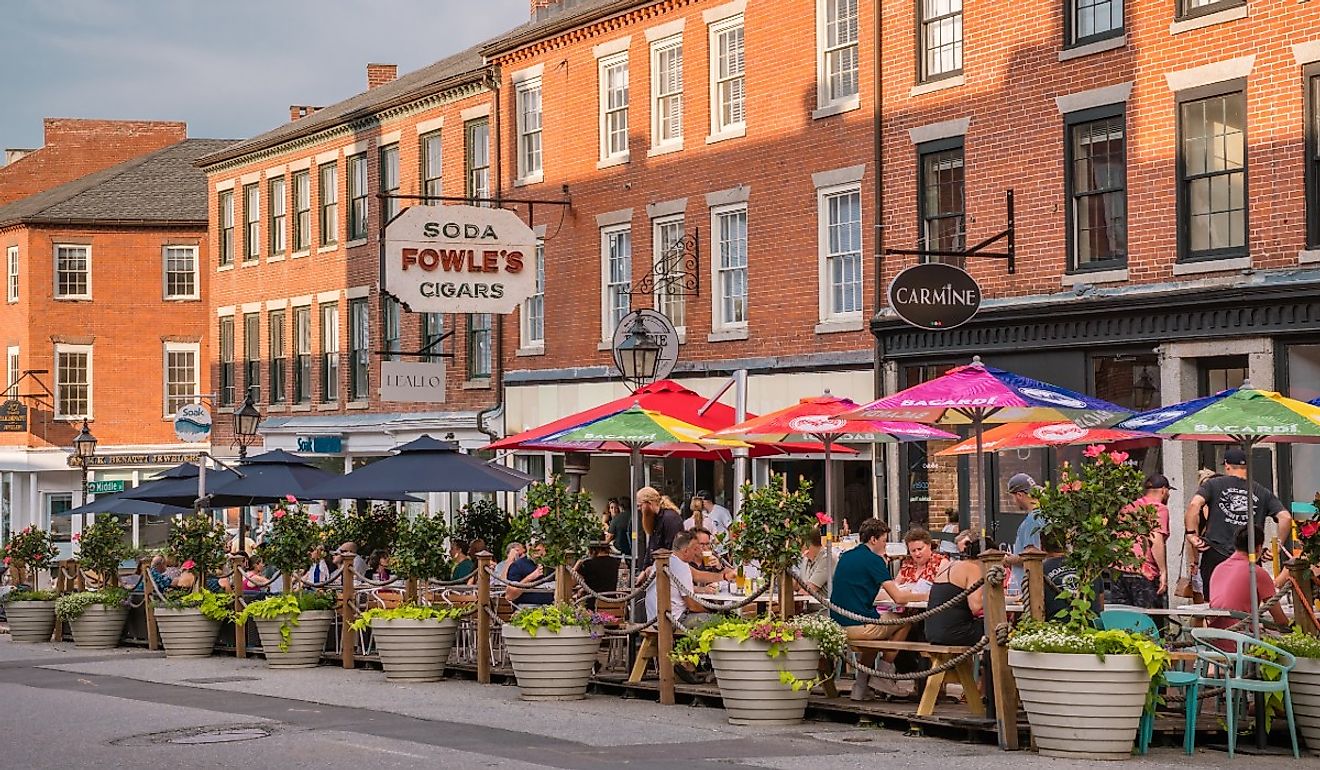Flags, Symbols & Currency of Dominican Republic
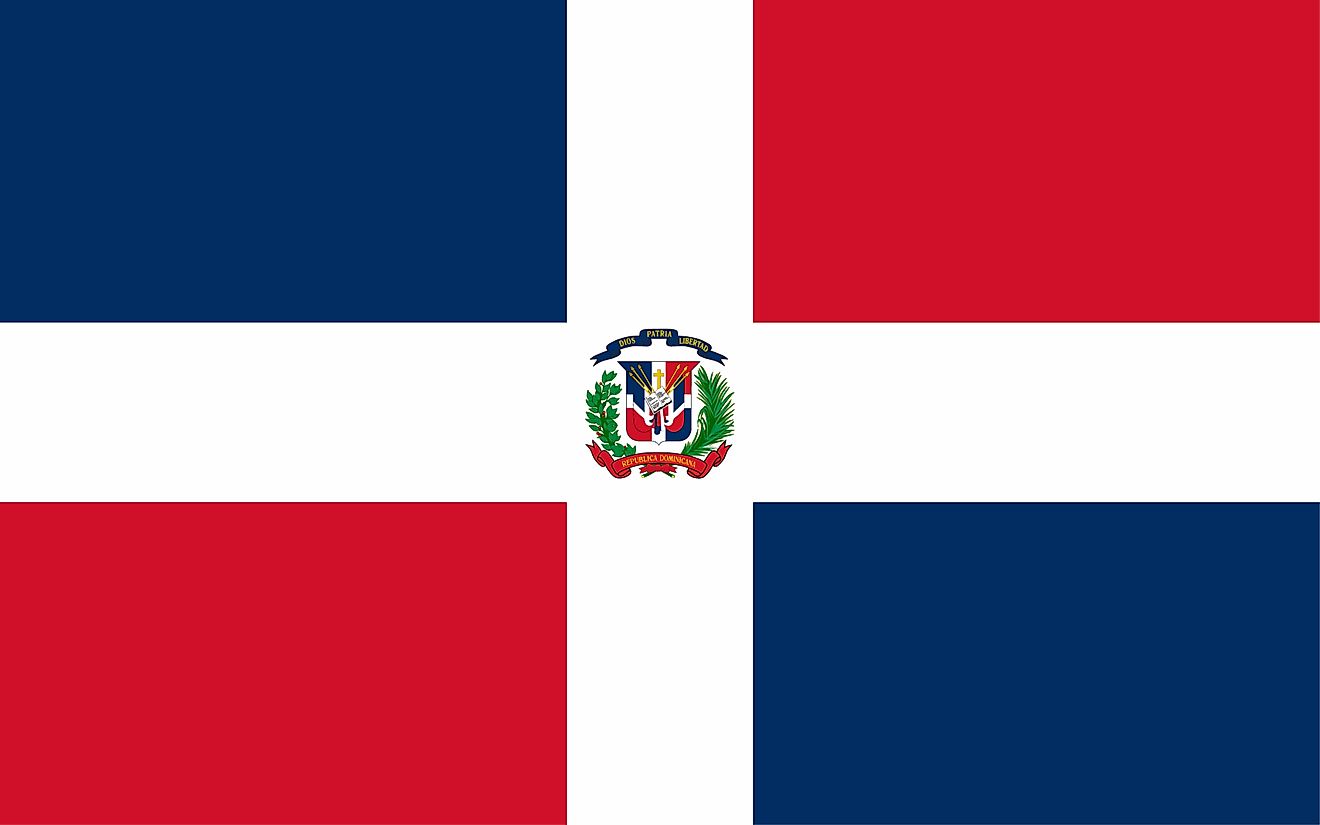
The National Flag of The Dominican Republic was officially adopted on November 6, 1844. The flag has been designed by Juan Pablo Duarte.
The National Flag of The Dominican Republic comprises a centered white cross that extends to the edges and divides the flag into four rectangles. The top rectangles are of ultramarine blue (hoist side) and vermilion red, and the bottom ones are of vermilion red (hoist side) and ultramarine blue. A small coat of arms, featuring a shield that is supported by a laurel branch (left) and a palm branch (right), is positioned at the center of the cross. Placed above the shield is a ribbon, displaying the national motto: “Dios, Patria, Libertad” (“God, Fatherland, Liberty”). Below the shield, is a red ribbon displaying: “República Dominicana”. In the shield a bible is opened to a verse of the Gospel of John 8:32, that reads: "Y la verdad nos hara libres" (And the truth shall set you free). The blue color of the flag represents liberty; the white color symbolizes salvation and the red color symbolizes the blood of fighters during the struggle for independence. The cross is a symbol of the country’s religious heritage. The flag has a width-to-length proportion ratio of 5:8.
History of the Flag of The Dominican Republic
The first flag of the Dominican Republic that was adopted in 1844 shared similar features with that of the modern flag, except that it lacked the Dominican Coat of Arms. The first flag had a design with both blue squares on the top and both red squares at the bottom. This design of the first flag was modified, rearranged, and along with the addition of the Coat of Arms was updated as the modern flag in 1849.
Symbols of Dominican Republic
The National Coat of Arms of The Dominican Republic

The current official National Coat of Arms of the Dominican Republic has been designed by Casimiro Nemesio de Moya – a Dominican Politician.
It features a shield in quartered colors of the national flag, with a laurel branch to the left and a palm frond to the right. The ultramarine blue ribbon above the shield displays the national motto: “Dios, Patria, Libertad” (“God, Fatherland, Liberty”). Below the shield, the words: “República Dominicana” appear on a red ribbon. In the center of the shield, flanked by six spears, is a Bible with a small golden cross above it. The pages are opened to the Gospel of John 8: 32, which reads, "Y la verdad os hará libres." (And the truth shall make you free). On it, there is a small golden cross, which along with the sacred Bible emerges from a trophy that is made up of two spears and four national flags.
National Motto
"Dios, Patria, Libertad" ("God, Fatherland, Liberty”)
National Anthem
- Anthem Title: "Himno nacional de República Dominicana"
- Music Composer: José Rufino Reyes y Siancas
- Lyricist: Emilio Prud'Homme
- Date of Adoption: May 30, 1934
"Himno nacional de República Dominicana" is the national anthem of the Dominican Republic. The music of the anthem was composed by José Rufino Reyes y Siancas and the lyrics of the anthem have been authored by Emilio Prud'Homme. The anthem was officially adopted as the national anthem on May 30, 1934.
"Himno nacional de República Dominicana" (Spanish)
Quisqueyanos valientes, alcemos
Nuestro canto con viva emoción,
Y del mundo a la faz ostentemos
Nuestro invicto glorioso pendón.
¡Salve! el pueblo que, intrépido y fuerte,
A la guerra a morir se lanzó,
Cuando en bélico reto de muerte
Sus cadenas de esclavo rompió.
Ningún pueblo ser libre merece
Si es esclavo indolente y servil;
Si en su pecho la llama no crece
Que templó el heroísmo viril,
Mas Quisqueya la indómita y brava
Siempre altiva la frente alzará;
Que si fuere mil veces esclava
Otras tantas ser libre sabrá.
Que si dolo y ardid la expusieron
De un intruso señor al desdén,
¡Las Carreras! ¡Beller!, campos fueron
Que cubiertos de gloria se ven.
Que en la cima de heroíco baluarte
De los libres el verbo encarnó,
Donde el genio de Sánchez y Duarte
A ser libre o morir enseñó.
Y si pudo inconsulto caudillo
De esas glorias el brillo empañar,
De la guerra se vio en Capotillo
La bandera de fuego ondear.
Y el incendio que atónito deja
De Castilla al soberbio león,
De las playas gloriosas le aleja
Donde flota el cruzado pendón.
Compatriotas, mostremos erguida
Nuestra frente, orgullosos de hoy más;
Que Quisqueya será destruida
Pero sierva de nuevo, ¡jamás!
Que es santuario de amor cada pecho
Do la patria se siente vivir;
Y es su escudo invencible el derecho;
Y es su lema ser libre o morir.
¡Libertad! que aún se yergue serena
La Victoria en su carro triunfal,
Y el clarín de la guerra aún resuena
Pregonando su gloria inmortal.
¡Libertad! Que los ecos se agiten
Mientras llenos de noble ansiedad
Nuestros campos de gloria repiten
¡Libertad! ¡Libertad! ¡Libertad!
National Anthem of the Dominican Republic
Brave Quisqueyans,
Let’s raise our song with vivid emotion,
From the world to the face of the earth
Show our unconquered glorious banner.
Hail, the nation who strong and intrepid,
Into war launched itself set to die
When in a warring challenge to the death
Its chains of slavery still it cut off.
No people deserves to be free
If it’s an indolent slave and servile;
If in its chest doesn't grow the flame
that forged virile heroism.
But Quisqueya the brave and indomitable
Always proudly her forehead will raise
For if she were a thousand times a slave
This many times it will be free.
And if fraud and cunning exposed her
To disdain of an intrusive man,
Las Carreras! Beler!...were fields
Which covered in glory were seen.
At the top of our heroic bastion,
Word of the free was materialized,
Where the genius of Sanchez and Duarte
Taught us to be free or to die.
And if could inconsiderate leader
Reduce the luster of these glories,
Of the war seen in Capotillo
The banner of fire waves on.
And the fire that leaves shocked
The arrogant lion from Castile,
Removes it from glorious beaches to
Where floats the banner that’s crossed.
Compatriots, let’s show erect our
Forehead, proud of today for;
Quisqueya will be destroyed
But it will never be again enslaved.
That every chest is of love a sanctuary
Where one feels the homeland lives;
It is the law her invincible shield;
It is her motto be free or die.
Liberty that still serenely lifts up
Victory in her triumphal carriage.
The trumpet of war still resounds
Proclaiming her immortal glory.
Freedom! Let the echoes agitate
While full of noble anxiety
Our battlefields of glory reverb these words -
Freedom! Freedom! Freedom!
The Currency of Dominican Republic is the Dominican peso (Peso dominicano)
The current official currency of the Dominican Republic is the Dominican peso [Peso dominicano] ("$" or "RD$"). One peso is divided into 100 centavos (cents).
Coins:
During the reign of Trujillo, coins featured symbols of the party or state. Commemorative coins have been in circulation since his assassination, and feature the Mirabel sisters and one of the country’s founding fathers (Juan Pablo Duarte). After the Declaration of Independence, coins were issued in the denomination of a quarter of a real. The circulation of 5, 10, and 20 US cents was authorized in 1848 and was circulated alongside 1, 2, and 20-peso banknotes. In 1937, coins in the denominations of 1, 5, 10, 25 centavos were released with all the coins bearing the national arms on the reverse. Currently, the Dominican Peso coins are in the denomination of 1, 5, 10, and 25 pesos.
Banknotes:
Banknotes have also been through numerous changes, with the current notes differentiated by colors and other features such as the country’s historical figures and landmarks. The first banknotes were issued in the denomination of 1, 5, and 10 and were similar in size and features to US dollars. Fractional notes or papers were also issued in the denomination of 10, 25, and 50 centavos. Currently, banknotes are made up of cotton and come in denominations of 20, 50, 100, 200, 500, 1,000, and 2,000.
Historical Currencies of The Dominican Republic
The first Dominican Peso has been in circulation since 1844 when the Dominican Republic was granted independence by Haiti. Before this, the country had several currencies. During Haitian rule, the Haitian gourde was the recognized currency. In 1877, the Dominican Peso was decimalized, subdividing it into 100 centavos, and issued alongside another currency known as the franco. In 1905, the US dollar replaced the peso at a rate of 5 pesos for one dollar. On February 21, 1937, the Dominican Peso (peso oro) was recognized as the country’s official currency. Several regulations were also put in place to ensure that the coins and banknotes are issued about the American currency. Since 2011, peso oro has been renamed as Peso dominicano.
